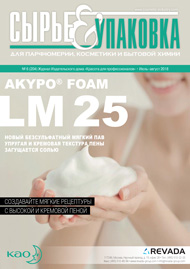NEWS
domestic chemistry Novelties
PACKAGING NEWS
BUSINESS NEWS
EVENTS
Novelty from Revada: Seminar for Cosmetic Producers
Revada held a seminar for cosmetic producers in the Petrof Palace on June7, where introduced the main novelties of its suppliers demonstrated at in-cosmetics Gloial-2018.
Silab: Nature, Science and Technology in the Service of the Global Cosmetic Industry
Experts could get to know the latest trends of the global cosmetic industry and sophisticated developments in the field of raw and technology for cosmetic in the Moscow Marriott Tverskaya Hotel on the 5th of June.
New Products and Concepts at Azelis Rus Workshop
The workshop of Azelis Rus, a leading distributor of specialty chemicals, took place in the Moscow Marriott Tverskaya Hotel on the 29th of May.
preview
in-cosmetics Global 2018: Hot Launches and Trends
In this review, we present some new products launched at the in-cosmetics Global exhibition, which took place this year in Amsterdam from April 17 to 19.
ACTUALLY
Microbiome – the «hot» topic in cosmetic industry
Averianova V. А., Ph.D (Biology)
The body’s microbiome is getting major attention these days and for good reason: it plays a certain role in skin health. From internal effects on food processing, to external effects for skin defense and more, it’s an exciting new organ for scientific exploration and formulation. But it’s also a highly complex entity due to its high level of variability within and between individuals. Nevertheless the potential for harnessing the skin microbiome for cosmetics and skin care is very strong and companies have begun to scale up the production of bacteria, used in cosmetics, and production of prebiotic cosmetic ingredients.
Different colors of chemistry: What do they mean?
With the Pollution Prevention Act of 1990, the United States established a national policy to prevent or reduce pollution at its source whenever feasible. Despite wide range of industries, including transportation and agriculture and activities whose pollution consequences are much greater than that of cosmetics and personal care, these latter industries can make their contribution to improving safety and reducing pollution. The US Environmental Protection Agency (EPA) adopted the term green chemistry to mean the use of chemistry for pollution prevention. More specifically, EPA says «green chemistry is the design of chemical products and processes that reduce or eliminate the use and generation of hazardous substances». White chemistry deals with renewable resources and it’s a part of biotechnology. These directions of chemistry, their challenges and achievements are discussed in this article.
experience
Toxicity Assessment of the Water-Soluble Ingredients for Cosmetics Using Cell Culture System
Vorobyova E.S.1, 2, Lukashina M.I.1, 3, Posvyatenko A.V.1, 3, Kibardin A.V.1, 3, Afanasov I.М.2, Larin S.S.1, 3
1 Institute of Gene Biology Russian Academy of Science
2 GF Group Limited Liability Company
3 Dmitry Rogachev National Medical Research Center of Pediatric Hematology, Oncology and Immunology
The potential danger of the toxic cosmetics ingredients’ penetration into the deeper skin layers keeps current the development of methods for evaluating product safety. This paper studies the toxicity assessment in vitro using a fibroblast culture as one of the main types of dermis cells. The presented method can be recommended for use to create and analyze cosmetics.
MARKETING
The Increasing Demand for Bio-Based Solvents
Solvents define a major part of the environmental performance of processes in chemical industry and also impact on cost, safety and health issues. The idea of “green” solvents expresses the goal to minimize the environmental impact resulting from the use of solvents in chemical production. Green solvents are made from the processing of agricultural crops: beat, sugars, corn and other products can be named biosolvents. Bio-based solvents act as a replacement for crude oil-based solvents and are just as effective, while also being safe. Thanks to their higher boiling point, low toxicity, recyclability, low miscibility and other features that crude oil-based solvents don’t have, sustainable solvents are getting a lot of attention. Many people are especially interested in the fact that green solvents don’t release the same high numbers of volatile organic compounds (VOCs) as petroleum-based solvents during manufacturing.
Ingredients
Polyvalent Environmental Friendly Ingredient for Cleaning, Solubilizing and more
F. Gauter, Kuraray Europe, France
MMB (3-methoxy-3-methyl-1-butanol) is a unique and useful fine chemical produced by Kuraray. It is a clear, colorless and completely water-soluble liquid. Due to its high flash point, it is not classified as a flammable chemical under the present EU chemicals regulations. MMB is a great help for those who are concerned about the environmental issues and has received a great deal of attention in many industrial fields thanks to its low toxicity and good biodegradability. Main areas of application: Household and Industrial cleaners, dry soaps, hand cleaners, air fresheners. It is biodegradable with a mild odor.
PACKAGING & LABLE
Sustainable packaging on the modern market
E. Berezina
Packaging sustainability has been on the world market for many years, but it has never been so acute and relevant as it is now. Rethinking the role that packaging plays in our lives and the environment has led to a complete overhaul of the market and a change of its structure. Manufacturers aimed at the production of eco- friendly packaging, not only found the right way to solve the problem, but also were able to introduce innovative developments in the modern packaging industry. Advanced technologies, new raw materials, safe ingredients and additives, all this brought the packaging industry to a higher level.
Not the last role was played by the development of organic and natural cosmetics and hygiene, a category of products that naturally required the same natural, «clean» packaging. This review offers to consider various options of modern «green» packaging and to get acquainted with the most vivid examples of eco-packaging.



